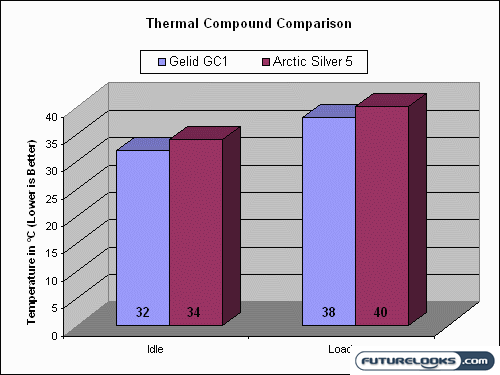Testing
To test the Gelid GC1 Thermal Paste, we pitted it against the venerable Arctic Silver 5 in a one on one battle royale. We applied one paste to our test rig and let it set for 24 hours at room temperature. Once it was set, we booted the computer and left if for 30 minutes to establish idle conditions. Temperatures were taken, and then SiSoftware Sandra’s system burn in tools were spooled up to torture test the heck outta the thermal paste. CPU usage was pushed to 100%, and was run at that for 1 hour. At the end of the hour, the temperature was taken. Wash, rinse, and repeat for the second thermal paste.
Here’s the specs on our test rig:
- AMD Phenom 9600 Black Edition 2.3GHz Quad Core CPU
- Asus M3A32-MVP Deluxe/WiFi-AP 790FX Motherboard
- OCZ Platinum XTC REV.2 PC2-6400 2GB 2X1GB DDR2-800 Memory Kit
- Foxconn 9800GTX-512N Extreme OC Video Card
- Seagate Barracuda 500GB 7200.10 16MB SATA2 Hard Drive
- Cooler Master Hyper 212 CPU Cooler
- Antec P182 Advanced Super Mid Tower Case
- Thermaltake Toughpower 1000W Power Supply
The results from our testing do tell an interesting story. It’s quite obvious from the chart that the Gelid GC1 compound beat the Arctic Silver 5 by a margin of 2°C in all tests. But if you dig deeper, you get a fair bit more information from these results.

It’s worth noting that not only did Gelid’s goop beat AS5, but it also maintained the same amount of temperature control as the AS5. The performance gap between idle and load conditions was 6°C with both compounds. This is important because if you are overclocking, or running a normally hot operating CPU, you want the temperatures to remain fairly consistent and not spike in any strange fashion. This will ensure that your hardware keeps working away happily. I think it’s easy to say that Gelid has won this round. Some of you may be grousing about the prescribed breakin time of Arctic Silver 5 which is 200 hrs and how we didn’t wait 200 hrs. Well, in our experience, we’ve only ever gained one or two degrees after the prescribed break in. Even then, you have to consider that the Gelid GC1 compound would also gain some ground as well. The GC1 still wins.
Some of you may be asking right now where the heck our overclocking tests have up and taken off to. Well it’s quite simple. Due to the abysmal overclocking abilities of our test CPU (AMD Phenom 9600 Black Edition), we weren’t able to squeeze many more MHz out of it. There was a minimal temperature burst, and the results were fairly similar to stock clocks. But based on our results, it is clear that replacing the Arctic Silver 5 with some Gelid Solutions GC1 may help you drop a few degrees with your own overclocking endeavors.
Final Thoughts and Conclusion
Thermal Compounds are simple products to review, but have a tremendous impact on the performance of your computer. The wrong thermal compound can cause spike in temperature that may cause your hardware to slow down, or die completely. With that being said, it’s nigh impossible to deny Gelid what they’ve done with their GC1 Thermal Compound. This goop performs better then the widely used Arctic Silver 5, and it’s cheaper to boot. The spreading accessory adds to the value of the GC1 package, and makes for a much better user experience.
As for the downsides, there really aren’t any of any significance. Performacne wise the Gelid GC1 compound is a solid performer. The only thing I could see popping up is a problem with availability should Gelid have problems getting into the North American market. In the end it’s just thermal compound folks. It either works better then the competition, or it doesn’t. Gelid’s GC1 high performance Thermal Compound fits into the former of those two statements. It works. It’s work well. It’s cheaper than the competition. That means it’s earns our Editors Choice and Value Added awards. ‘Nuff said.
The Good
- Easy to apply
- Great Value
- Non Conductive
The Bad
- We still need to see how availability pans out
Overall Rating: 9.5/10.0


Discuss This Review in the Futurelooks Community Forums
Real-Time Price and Stock Check – Check Other Products
